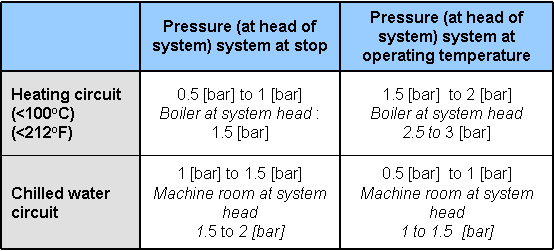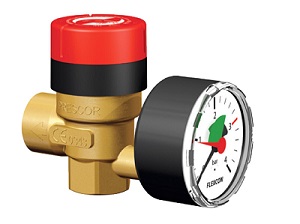We can therefore note for memory the following range of scale:

Question
With the pump off, we measure a pressure of 3.5 [bar] in a machine room. At the same time we measure at another point of the same hydraulic system a pressure of 4.7 [bar].
What is the level of this point in relation to the boiler?
12 [m] (39.4ft)
Explanation :
The second measurement is higher than that of the machine room. The first point is therefore below.
We know that a bar corresponds to 10 [mH2O] (32.8 ftH2O).
4.7 – 3.5 = 1.2 [bar]
The first point is therefore 12 meters (29.5 ft) lower than the machine room.The safety valve situated in the machine room opens if the pressure becomes excessive.

Question
In a roof-top machine room the safety valve is set to open at 3 [bar].
Ignoring the influence of the pump, what maximum pressure can a unit reach if situated 35 [m] (115 ft) lower?
6.5 [bar]
Explanation:
When the valve opens, the machine room has reached the maximum authorized pressure of 3 [bar].
At the same time a unit 35 [m] (115 ft) lower will bear a pressure of:
3 [bar] + 3.5 [bar] = 6.5 [bar]
Question
The safety valve situated in a machine room is set at 4 [bar].
Ignoring the influence of the pump, what maximum pressure can a unit reach situated 15 [m] (49.2ft) above.
2.5 [bar]
Explanation:
The safety valve being set at 4 [bar] and the unit is 15 [m] (49.2 ft) lower than the machine room.
When the pressure is at its maximum in the machine room, the unit only bears:
4 [bar] – 1.5 [bar] = 2.5 [bar].
Question
At the end of water filling, we measure 2.8 [bar] at the boiler and at the head of the system a pressure of 0.5 [bar].
With the heating at operating temperature, the expansion of water leads to an increase in pressure and we measure a pressure of 3.7 [bar] at the boiler.
Ignoring the influence of the pump, what at the same moment is the pressure at the head of the system?
1.4 [bar]
Explanation:
With our first measurements we can deduce that the head of the system is:
23 [m] (75.5ft) above the boiler (2,8 [bar] – 0,5 [bar]).
If the boiler climbs to 3.7 [bar], the head of the system will climb to:
3.7 [bar] – 2.3 [bar] = 1.4 [bar].
Note that the pressure increase at the boiler due to water expansion is:
0.9 [bar] (3.7 [bar] – 2.8 [bar]).
This pressure increase transmits to all points of the system.
At the head of the system, the pressure has indeed risen by :
0.5 [bar] + 0.9 [bar] = 1.4 [bar]
Question
At the end of water filling, we measure at a chilling unit at stop a pressure of 2.8 [bar] and at the head of the chilled water circuit a pressure of 1.5 [bar]
With the system at operating temperature, the retraction of water leads to a drop in pressure and we measure a pressure of 2.3 (bar] in the machine room.
Ignoring the influence of the pump, what at the same moment is the pressure at the head of the system?
1 [bar]
Explanation:
From the first measurements we can deduce that the head of the system is 13 [m] (42.7 ft) above the boiler (2.8 [bar] – 1.5 [bar]).
If the pressure in the machine room drops to 2.3 [bar), the head of the system is therefore at:
2.3 [bar] – 1.3 [bar] = 1 [bar].
Note that the drop in pressure due to the retraction of water is 0.5 [bar] (2.8 – 2.3 [bar]).
This pressure drop transmits to all points of the system.
At the head of the system the pressure has indeed dropped by:
1.5 – 0.5 [bar] = 1 [bar]
